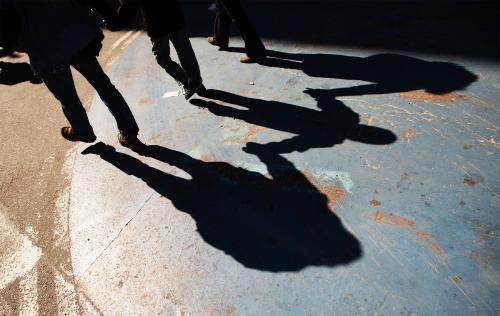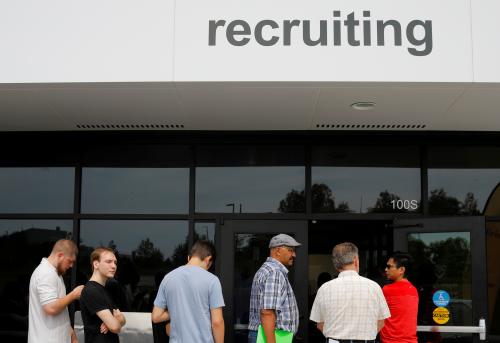This article originally appeared in Real Clear Markets on November 28, 2018.
From the perspective of workers, the U.S. unemployment insurance (UI) system is one of the least generous in the industrialized world. This is not because weekly payments offered by the program are unusually low. In the case of American workers who earn average or below-average pay, the percent of lost earnings replaced by UI benefits is about average among the rich countries. The distinctive feature of the U.S. system is that benefits do not last very long. In a typical state, a newly jobless worker is eligible to collect benefits for at most six months. In nine states, benefit durations are even shorter than that. In Florida and Missouri, new beneficiaries are currently eligible to receive at most three months of benefits. Is three months enough? Many rich countries offer combinations of unemployment benefits and unemployment assistance that last for a year or longer. Very few offer benefits as short as six months.
Before the Great Recession, it was rare for states to limit jobless benefits to less than six months. The fact that nine states now do so represents a notable benefit cut for the U.S. program. Little evidence indicates that states shortened the maximum benefit duration based on careful consideration of the pros and cons of different benefit limits. The main reason states took this step was to reduce the cost of their programs and keep employer contributions low. Did the cuts improve workers’ well-being? Did they yield better job search outcomes? It’s hard to say, but these were minor considerations in the policy shift.
The Great Recession certainly drove up program costs. Benefit outlays under regular state UI programs increased more than 145 percent between 2007 and 2009. States reacted differently to the resulting cost pressure. Many borrowed funds from the federal government to pay for benefits when their own state unemployment reserves were depleted. Federal law requires states to repay the loans in a timely fashion. If they are not repaid, the federal government imposes a penalty tax rate on a state’s employers until the loan is repaid. The tax penalty increases in each successive year that a loan remains unpaid.
Naturally, employers in a state object to payroll tax hikes, especially in the midst of a recession. They lobby state legislators to adopt policies that minimize the need for higher taxes. The rout of Democrats and the triumph of conservatives in the 2010 elections made state lawmakers receptive to employers’ pleas. In a fifth of states, UI laws were amended to reduce the potential duration of workers’ UI benefits. (Only one state has rescinded the cut.)
The unemployment insurance program is not a single national system. It is a collection of 50 state systems, each of which must follow some basic federal guidelines. States have considerable latitude to determine their own payroll taxes, payment formulas, and benefit limits. One result is that there are wide differences in the generosity of different state programs. In 2017, only about a quarter of the nation’s unemployed were covered by UI claims filed under regular state programs. However, this fraction varied widely from state to state, ranging from 10 percent of the unemployed in North Carolina up to almost half the unemployed in Massachusetts.
Part of this coverage gap is due to differences in the characteristics of the unemployed in different states. First-time job seekers, the long-term unemployed, most unemployed workers who quit their jobs, and workers who have spotty work records are generally ineligible for benefits. However, much of the difference in state coverage rates is traceable to differences in the generosity of states’ UI programs. Oregon and Florida had virtually identical unemployment rates in 2017, but while one-third of Oregon’s unemployed collected a UI check in that year, just 11 percent of the unemployed did so in Florida.
The least generous feature of the U.S. system has become even less generous, with scant discussion of the implications for workers’ well-being and for macroeconomic stabilization.
The cutbacks in potential benefit duration are clearly linked to drops in the percentage of unemployed who collect a UI check. The Labor Department calculates the UI recipiency rate as the fraction of the unemployed who are covered by a continued claim for regular UI benefits. Between 2006-2007 and 2016-2017, the UI recipiency rate in the nation as a whole fell a bit less than one-quarter. The three states with the biggest proportional drops in their recipiency rates were North Carolina, Florida, and Georgia. Each of these states saw their recipiency rates fall by at least half. Each of these states also cut the maximum duration of UI benefits. North Carolina and Florida now limit UI benefit payouts to 12 weeks; Georgia limits benefits to 14 weeks. All but one of the states cutting benefit durations after 2010 saw bigger-than-average drops in their UI recipiency rates.
Five of the nine states that reduced benefit durations linked their cuts to changes in the state unemployment rate. If the state unemployment rate should rise, the maximum duration of UI benefits will also increase. While this link makes sense, the fact remains that at most levels of unemployment—including today’s—the maximum duration of benefits is substantially lower than it was when unemployment rates were similar in the 1960s and late 1990s.
The goal of the U.S. unemployment insurance is to replace workers’ earnings that are lost as a result of layoffs. The income replacement provided by UI is only partial and temporary. With very little debate, states have moved to limit the duration of UI benefits below the duration that was standard in the five decades before 2010. The least generous feature of the U.S. system has become even less generous, with scant discussion of the implications for workers’ well-being and for macroeconomic stabilization. The aim of the shift has plainly been to reduce payroll tax burdens on employers. Unlike other safety net programs, however, the cost of UI has been shrinking over time rather than growing. Measured as a percentage of money wages, the cost of state-funded UI benefit payments hit a historical low last year.
In recent recessions, actions by Congress have offset the cumulative impacts of state-level cuts in unemployment insurance. The measures temporarily boost UI benefit durations and permit the unemployed to draw benefits for longer than six months, sometimes for as long as 23 months. These special federal programs have paid for an increasing percentage of UI benefits in recent recessions. By enacting temporary unemployment compensation programs fully funded by the federal government and temporarily subsidizing state extended UI benefit programs, Congress has preserved UI’s status as the nation’s most important counter-cyclical spending program. However, this achievement has depended on timely Congressional action. In a future recession, a divided Congress might delay or fail to establish a temporary extended benefit program. If that happens, past and future cuts in state UI programs will exact a toll. The UI system will deliver less counter-cyclical stimulus and weaker income support than has been the case in past recessions.
The Brookings Institution is committed to quality, independence, and impact.
We are supported by a diverse array of funders. In line with our values and policies, each Brookings publication represents the sole views of its author(s).






Commentary
Op-edWhen the next recession hits, will unemployment benefits be generous enough?
November 28, 2018